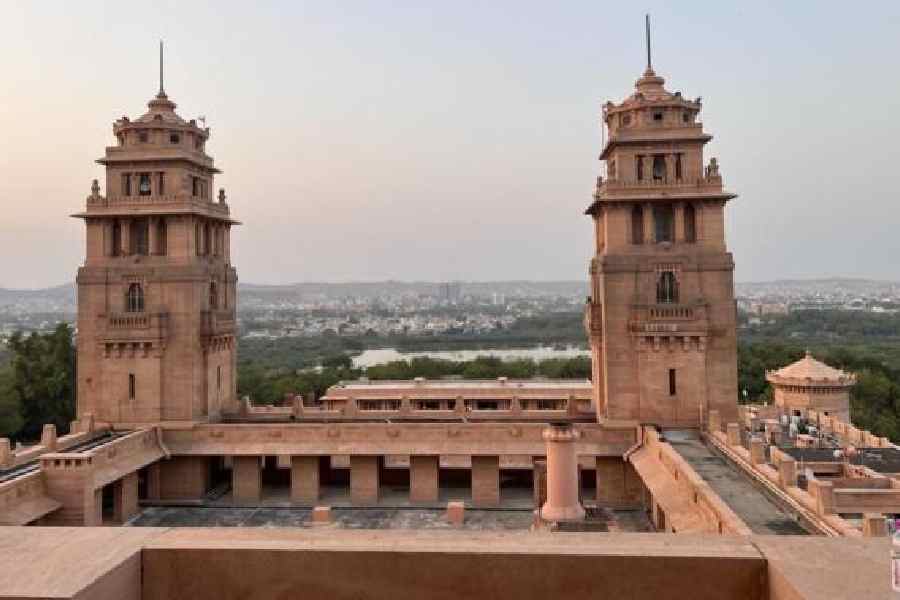As our direct flight from Calcutta touched down in Jodhpur, Rajasthan seemed to welcome me with open hearts and open arms. Rich in heritage, the city is also known as the cultural capital of the state. The people of the city are simple and know well how to make you feel special. No matter what someone is doing, if you happen to pass by, they will stop their work and say namaste without missing a beat.
Khamma ghani means ‘welcome’, or ‘we welcome you’. You’ll also regularly hear things like “Virajo sah” and “Hukum sah”, which are all about respectful behaviour in a lovely language. Most people will address you as hukum, which means sir or madam, and request you to virajo, which is the equivalent of baithiye in Hindi or boshun in Bengali (please sit). Anywhere you go — restaurants, shops, hotels — they will first ask you to virajo with all their heart. I have heard this word in my childhood, but here I’ve seen and experienced it being used and was fascinated.
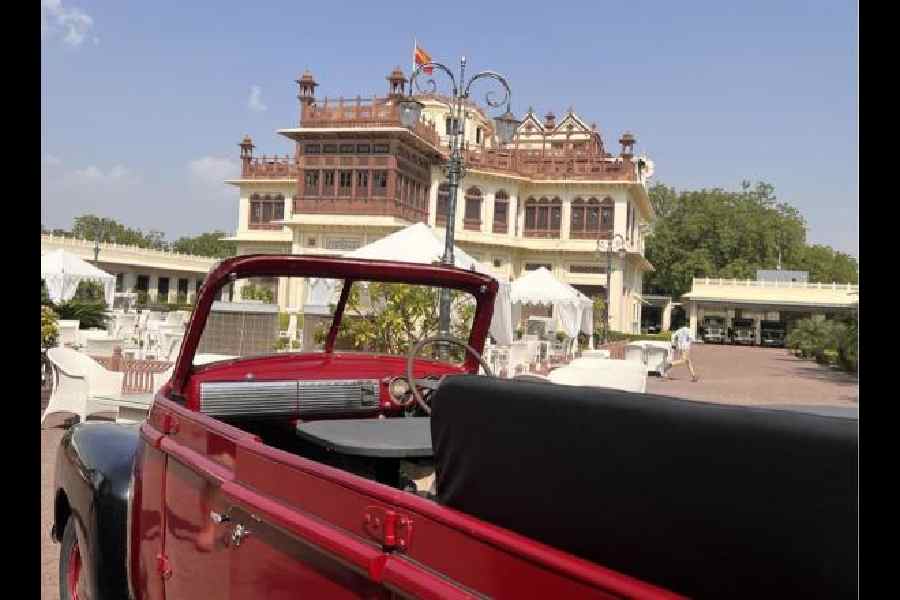
Khaas Bagh is a boutique hotel with just seven rooms and has its own vintage car collection
People in Jodhpur work for generations perfecting a particular art. Whoever I had a conversation with said that they had been in that field for at least 30-40 years and though it’s a second-tier city, loyalty is still deeply embedded there. Being a small-town girl, these small things touched my heart.
Royal welcome
Staying at the Umaid Bhawan Palace is an experience. Right from the reception to the antique lift, to the lobby, to the rooms — the list goes on. When we entered the hotel, the general manager Manu Sharma gave us a grand welcome. Petals were showered on us, we were garlanded and offered a welcome drink. A troupe welcomed us with a local dance and we joined in.
There was no check-in hassle or formalities. It was a direct-to-room entry. Staying here is out of the world. Each member of the hotel family was eager to help and pay their respects. The lift is an antique one with a sofa, no less, and it makes you feel like a royal!

Mirchi Vada and Pyaaz Kachori are two iconic food items of Jodhpur and a few lakh of these are consumed every day
The next morning
The breakfast area was situated outdoors at the back of a large garden with live Indian classical music playing in the background. The weather was perfect and I had never seen such a beautiful breakfast setup in my life. It was sumptuous! They spoiled us with their luxurious breakfast spread — Pyaaz Kachori, Mirchi Vada, all kinds of south Indian spread, parathas, and what have you, with Indian masala tea to round things off. This was topped with their unparalleled warm hospitality. This is Indian and Rajasthani hospitality which you will not get anywhere in the world.
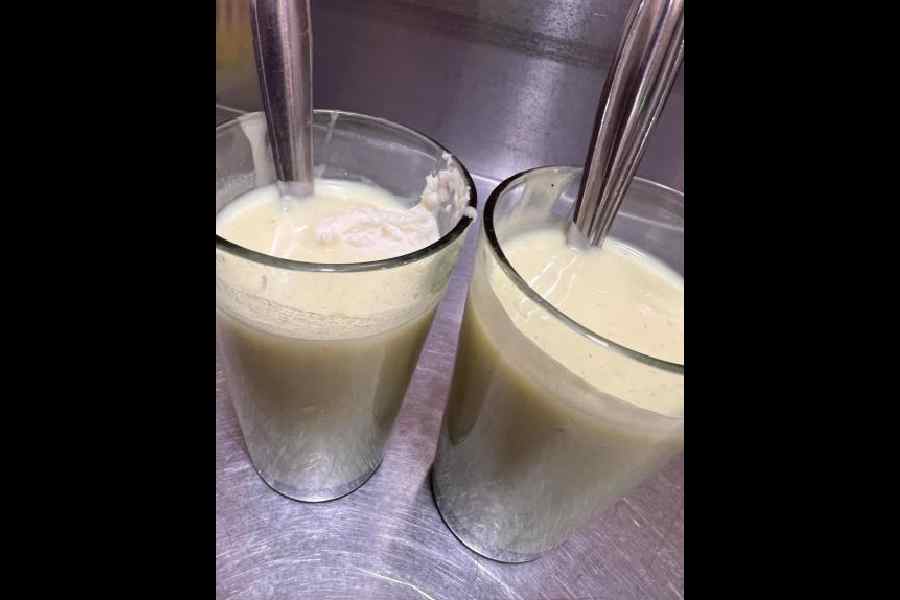
Makhania Lassi, or lassi with butter, is a Jodhpur special
“Hukum kal kya khayenge?” (Your majesty, what would you like to have tomorrow?) Prachi, my younger daughter who is a special child, was served and taken care of so lovingly for each and everything — something rarely experienced by us.
I wrote this article sitting in the breakfast area itself. It was so peaceful. There are peacocks that roam the grounds, and you can feed them too. I had the chance to feed one peacock that was close by. A different guest’s croissant must have looked appealing to another peacock because it came, inspected, and then took off with it!
In Jodhpur, every day is a royal affair!
Umaid Bhawan Palace
It was built by Maharaja Umaid Singhji. Construction started in 1929 and it was finally finished in 1943. Before that the royals lived at Mehrangarh Fort till the late 19th century and then shifted to the Raika Bagh Palace before shifting here, their current residence, which is one of the world’s largest private residences. The palace has three parts: Regal, Mardana and Janana. The central dome is above the sky-blue inner dome. The lounge area has pink sandstone and marble flooring. It has a massive 347 rooms. Later, the palace was divided into three parts: the hotel, the museum and the king’s private palace.
Presently the hotel — managed by the Taj Group — has 70 rooms. There are 13 Regal, 40 Mardana, and 17 Janana rooms. The hotel has indoor and outdoor swimming, a ballroom, a banquet hall, a sprawling garden, a spa area, multiple outdoor sports areas, lounges, and the dome area.
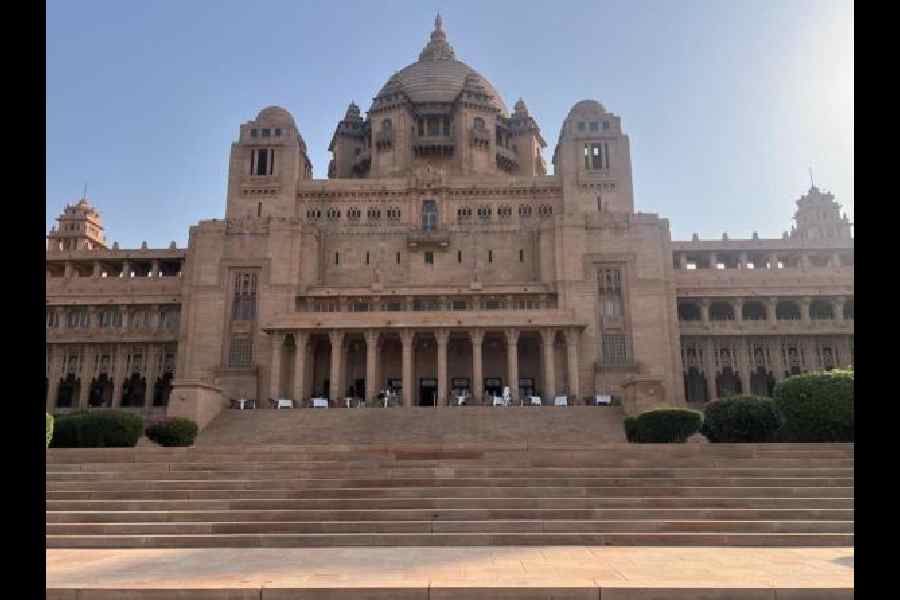
The Umaid Bhawan Palace Hotel
The biggest suite here is the Maharaja and Maharani Suite, where Maharaja Gaj Singh and his mother used to live. It has one bedroom, two living-cum-dining rooms, a couple’s massage room, a dressing room, an old-style shower-cum-steam, a study table and a huge verandah overlooking the museum. The suites were designed by Stephen Norbin, a Polish painter and graphic artist, who spent three fascinating years in Jodhpur between 1942 and 1945. The walls of these rooms have huge paintings made by him. This suite is 4,500sq ft and they have an interconnected suite, too, for kids. The verandah flooring is a turquoise blue mosaic, very pretty.
The Maharani suite overlooking the huge garden is much bigger and has a pantry in it. Everywhere the floor is mosaic, marble, and wood. It is 4,800sq ft and the verandah has an off-white mosaic floor.
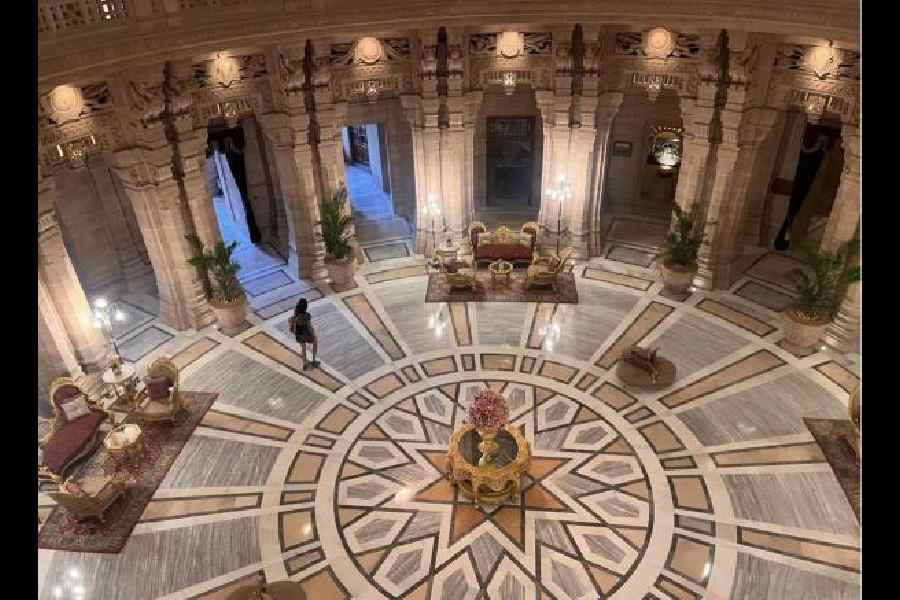
An aerial view of the grand lobby of the Umaid Bhawan Palace Hotel
The Umaid Bhawan Palace Museum houses a variety of items which the royal family would use, including their rare images, collection of vintage clocks and cars.
The King’s Palace, their private royal residence, has 40 rooms near the Janana part of the palace. The rest forms the museum.
Royal respect
Royal families are respected a lot in Rajasthan. Maharaja Gaj Singh is called Baap Ji, meaning a father figure to all. People talk with great respect about the royal family and him. Baap Ji is a great enthusiast
of tourism — because of him tourism has developed so much in Jodhpur.
He has opened up his home, his palace, to promote tourism by turning part of it into a hotel and part of it into a museum.
A simple and down-to-earth person, he lost his father (a trained pilot who unfortunately passed away in a tragic plane crash while landing his plane) at an early age. We got the chance to meet Baap Ji at his palace and we paid our reverence by offering a saafa to him — a tradition followed for the royals. Saafa is the local word for turban. He met us very warmly — I presented my memoir to him and also showed him my documentary in which he took great interest. He invited us to Raavan Dahan the next day and to the Yuvraj Shivraj Singh Neuro Rehabilitation Centre run by his foundation, Indian Head Injury Foundation (IHIF), the day after. It is a physiotherapy centre for patients who had brain injury and children with cerebral palsy.
Ravan Dahan on Vijaya Dashami:
My husband Sanjay got the royal invitation to join the convoy and attend along with the royal families. It is a ceremony which is attended only by men. They all attended and came back to Baap Ji’s palace where Maharani Sahiba applied the vijay tilak to all of them after the Raavan Dahan.
Mehrangarh Fort
This is where the royal family used to live before they moved to Umaid Palace. Built by Jodha Rao in 1459, it has seven entrances to it. The fort has intricate carvings, sprawling courtyards, balconies, and galleries. It also has the best-stocked museum in Rajasthan. Within the precincts are opulent palaces such as the Sheesh Mahal, which is decked from ceiling to floor with intricate mirror work, and Phool Mahal, the most ornate hall of the fort decked with gold and decorated to look like a flower.
Local life
To know any place, I always talk to the locals. Their local language is a Marwari dialect which is slightly different from the Shekhawati language that we speak as I found out after visiting Jodhpur. Their literacy rate is 80.81 per cent and female literacy rate is 73.46 per cent.
Jodhpur as a city is not crowded and there are practically no traffic jams. It takes 10-15 minutes to go anywhere. It’s a great tourist place for winters. There is less pollution too, so the sun is very strong in the summers.
To pay respect to guests, the people here give saafas/pagdis — just the way we give uttoriyos in West Bengal. Here, men hardly wear any suits — they proudly wear, even flaunt, Jodhpuri bandhgalas, half jackets, and breeches with saafas for formal functions. Here culture is etched in every step.
The story of the blue city of Jodhpur is that while painting their homes with choona (lime) they would add blue colour to make it look whiter. In Jodhpur, the blue colour was used in large quantities. Hence, all the homes got tinted slightly blue. Also, during summers the temperature reaches 50°C. So, to absorb the heat the colour blue was used. That’s how they started calling it the ‘blue city’.
To know any culture, you have to taste the local food. Broadly, it is almost the same all over Rajasthan. Daal, baati, churma, gatta, mangori — all are dry preparations. In ancient days, Rajasthan, being a desert, did not have green vegetables available easily. So, the food is predominantly dry and can be used for days. They used atta, besan, bajra, millets — all in dry form. Achar, kes, sangar and papad are made abundantly. Lassi, buttermilk, butter and ghee are also used plenty.
Jodhpur might be a chhota sheher, but it has a bada dil.
